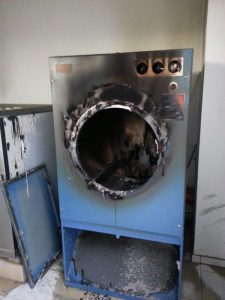Fats and oils are the trigger
A frequent cause of fire
Especially in the hotel and catering industry, but also in commercial laundries and private households, fires occur time and again due to spontaneous combustion of laundry. Thus, it is possible that freshly washed and dried piles of laundry or folded and stacked textiles in shelves, baskets or laundry containers self-ignite. There are also known cases of self-ignition of textiles in the dryer – without the dryer being in operation. Such fires often occur outside normal working hours, are usually discovered late, and cause considerable damage to property.
Spontaneous combustion is the term used when ignition occurs without any external energy supply. However, before a textile catches fire, self-heating to the ignition temperature first takes place, usually due to a buildup of heat after drying.
Fire initiation in textiles
Hotel and catering textiles, such as cleaning cloths, towels and clothing, frequently come into contact with vegetable or animal fats or oils – after all, pans, extractor hoods or deep-fat fryers, for example, are cleaned regularly. But also towels and bathrobes from the wellness area of hotels can be contaminated with massage oil. Such fats and oils usually contain so-called unsaturated fatty acids, which can cause a fire under unfavorable conditions. Washing textiles soiled in this way often does not completely remove the adhering fat or oil from the fabric, which would not yet lead to spontaneous combustion at room temperature. After washing, the textiles are usually dried in a tumble dryer and then stacked while still warm on a pile of laundry, on shelves or in laundry transport carts. The drying process creates a higher initial temperature for the reaction, which continues to increase in the laundry pile. The initially slow reaction, together with the insulating effect of the neighboring laundry, can now result in the temperature for spontaneous combustion of the laundry being reached.
Preventive fire protection measures
To prevent spontaneous combustion of laundry, several points should be considered:
- Wash textiles heavily soiled with grease or oil separately.
- Use a specially adapted washing program
- Use a special grease remover in addition to your detergent
- Avoid overloading your washing machine
- Check the washing result regularly
- Take into account the maximum load of your tumble dryer.
- Do not remove laundry from the dryer until the cooling phase in the drying program has been completed
- Never leave hot laundry in the dryer for a long time or overnight
- Spread out warm textiles so that the heat cannot build up
- Allow dried textiles to cool down for some time before stacking or packing them
What is spontaneous combustion in a laundromat?
Spontaneous combustion in a laundromat refers to the unexpected ignition of laundry items without an external heat source. It occurs when textiles, often contaminated with fats or oils, self-heat and eventually catch fire. This phenomenon poses a fire risk, especially in commercial laundromats and industrial laundry settings.
What causes laundry fires?
Laundry fires can be triggered by spontaneous combustion when textiles, typically soiled with fats or oils, undergo self-heating and reach their ignition temperature. The buildup of heat during drying and stacking of warm laundry can lead to these fires, especially in environments like hotels, restaurants, and commercial laundries.
Can clothes catch fire from heat?
Yes, clothes can catch fire from heat if they are exposed to high temperatures for an extended period. While spontaneous combustion is one way clothes can catch fire, direct exposure to heat sources, such as flames or hot surfaces, can also lead to clothing ignition.
What is spontaneous combustion of kitchen towels?
Spontaneous combustion of kitchen towels occurs when towels contaminated with cooking oils or grease undergo self-heating and eventually catch fire without an external heat source. The fats and oils in the towels contain unsaturated fatty acids that can contribute to this combustion.
What are the 5 examples of spontaneous combustion?
Examples of spontaneous combustion include fires caused by oily rags, hay or straw piles, coal dust, cottonseed oil, and certain chemical reactions. In laundry settings, spontaneous combustion can occur due to fats and oils present in textiles.
What triggers spontaneous combustion?
Spontaneous combustion is triggered by a combination of factors, including the presence of flammable materials (such as fats and oils), heat buildup, and insulation from surrounding objects. The self-heating process begins when the materials reach a critical temperature.
How common are laundry fires?
Laundry fires, particularly those resulting from spontaneous combustion, are relatively uncommon but pose a serious risk, especially in industrial and commercial laundry facilities. Preventive measures and proper laundering practices are essential to reduce this risk.
Can hot clothes catch fire?
Hot clothes, especially if contaminated with flammable substances like fats or oils, can catch fire under certain conditions. It is crucial to handle and store hot laundry items carefully to prevent the risk of combustion.
How common are washing machine fires?
Washing machine fires are relatively rare but not impossible. They can occur due to electrical faults, overheating, or misuse. Regular maintenance and safe usage practices can help reduce the likelihood of washing machine fires.
How do you prevent a laundry fire?
To prevent a laundry fire, especially from spontaneous combustion, consider washing heavily soiled textiles separately, using appropriate washing programs and grease removers. Avoid overloading washing machines, ensure proper drying, and allow textiles to cool before stacking or packing. These preventive measures help mitigate the risk of laundry fires.
More information and interesting facts: You want to know more about this or any other topic related to laundry technology. Contact us directly, call us, write to us or visit our website. We will be pleased to inform you …




